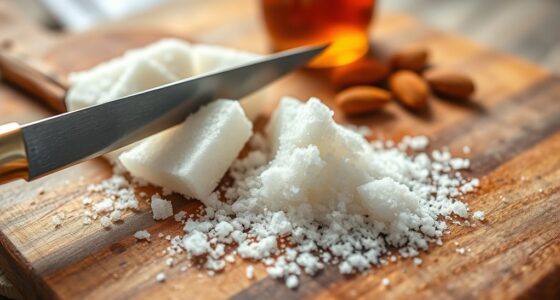You can make tasty, low-sodium meals by using herbs, spices, and acidic ingredients like lemon juice or vinegar to boost flavor without salt. Experiment with herb blends such as basil, oregano, and thyme, and add pungent spices like cumin or paprika for depth. Incorporating fresh herbs and a splash of acidity creates layered tastes that satisfy your palate. Keep exploring these strategies, and you’ll discover even more ways to enjoy flavorful, healthy dishes without the salt shaker.
Key Takeaways
- Use dried or fresh herbs like basil, oregano, and parsley to add depth without salt.
- Incorporate pungent spices such as cumin, paprika, and turmeric for bold flavor.
- Brighten dishes with lemon juice or vinegar to enhance taste without sodium.
- Gradually reduce salt and taste frequently to adapt your palate to more flavorful, low-sodium meals.
- Combine herbs, spices, and acids to create layered, satisfying flavors that eliminate the need for salt.

Herb blends are a fantastic way to add depth to your dishes without salt. They combine dried herbs such as basil, oregano, thyme, rosemary, and parsley, creating complex flavors that mimic the richness salt provides. You can find pre-made herb blends or make your own at home, customizing the mix to suit your taste preferences. For example, a Mediterranean herb blend can brighten up roasted vegetables or grilled chicken, while a French herb mixture works beautifully in stews and soups. Using fresh herbs when possible also enhances flavor; sprinkle chopped cilantro or dill over salads, or add fresh basil to pasta. These herbs not only add flavor but also provide beneficial nutrients, making your meals more wholesome. Incorporating herbs and spices can also help you explore culinary creativity and develop a more nuanced palate. Splice alternatives are equally effective in reducing sodium without sacrificing taste. Think beyond the typical salt and experiment with pungent spices like cumin, paprika, turmeric, garlic powder, onion powder, and chili flakes. These spices can bring heat, earthiness, and warmth to your dishes, making them more enticing. For example, a dash of smoked paprika on roasted vegetables adds smoky flavor, while a pinch of cinnamon can sweeten up savory dishes like chili or stews. Using acidic ingredients such as lemon juice or vinegar can also brighten flavors, making dishes taste vibrant without salt. Combining these spices and acids creates a layered taste experience that keeps your palate satisfied and enthusiastic for more. The key is to be creative and intentional with your seasoning choices. Start by reducing your reliance on salt gradually, replacing it with herb blends and spice alternatives. Taste as you go to find the right balance, and don’t hesitate to experiment with different combinations to discover what works best for you. Over time, your palate will adapt, and you’ll find that flavorful, satisfying meals are entirely possible without excess salt. Embracing these flavorful alternatives not only improves your cooking but also supports your overall health by reducing sodium intake, helping you enjoy meals that are both delicious and nourishing.
Frequently Asked Questions
Can I Substitute Salt With Other Seasonings Effectively?
Yes, you can effectively substitute salt with other seasonings. Salt alternatives like potassium chloride or flavored salts add complexity without extra sodium. Use herbs, spices, citrus zest, and vinegar as natural flavor enhancers to boost taste. Experiment with combinations to find what works best for your dishes. This way, you maintain flavor while reducing sodium, making your meals healthier without sacrificing deliciousness.
How Do I Prevent Food From Tasting Bland Without Salt?
You don’t have to settle for bland food; instead, you can enhance flavor with clever spice combinations and flavor boosters. Use fresh herbs like basil or cilantro for brightness, add acidity with lemon or vinegar, and incorporate aromatic spices such as cumin or paprika. These elements create depth and excitement, transforming dishes into vibrant, satisfying meals without relying on salt. Experimenting with these techniques keeps your cooking lively and delicious.
Are Low-Sodium Diets Suitable for Athletes?
Yes, a low-sodium diet can suit athletes if you carefully manage your sodium restriction. It’s essential to balance electrolyte intake to support athletic performance, especially during intense activity. You should focus on consuming natural sources of sodium, like lean meats and dairy, and hydrate properly. Consulting a sports nutritionist can help tailor your diet, ensuring you maintain energy levels and prevent dehydration without excess salt.
What Are the Best Herbs for Enhancing Flavor?
You’ll love experimenting with herbs like basil, thyme, and rosemary to enhance flavor without salt. These aromatic herbs are perfect for creating delicious herb flavor combinations, adding depth and aroma to your dishes. Use fresh parsley or cilantro for bright, vibrant notes or incorporate oregano and sage for savory richness. Aromatic herb uses include garnishing salads, seasoning meats, or infusing oils, making every meal flavorful and satisfying without relying on salt.
How Do I Read Labels for Sodium Content?
When reading labels, check the sodium content per serving to keep track of intake. Look for words like “low sodium,” “reduced sodium,” or “no added salt” to find healthier options. Be mindful of portion sizes, as larger servings can mean more sodium. Compare brands to find lower-sodium choices and avoid products with ingredients like sodium citrate or sodium phosphate. Staying vigilant helps you manage sodium without sacrificing flavor.
Conclusion
By mastering low-sodium cooking, you’re opening the door to vibrant, flavorful meals that don’t rely on salt to shine. Think of your kitchen as a garden of endless possibilities, where herbs, spices, and fresh ingredients bloom with taste. Embrace these techniques, and you’ll discover that delicious food can be both heart-friendly and satisfying. With each mindful choice, you’re painting a healthier future—one flavorful bite at a time.








